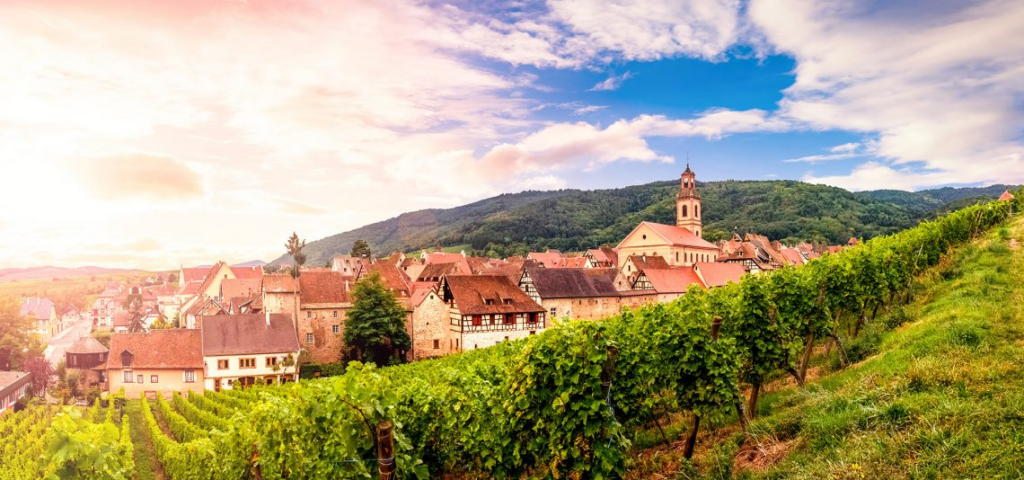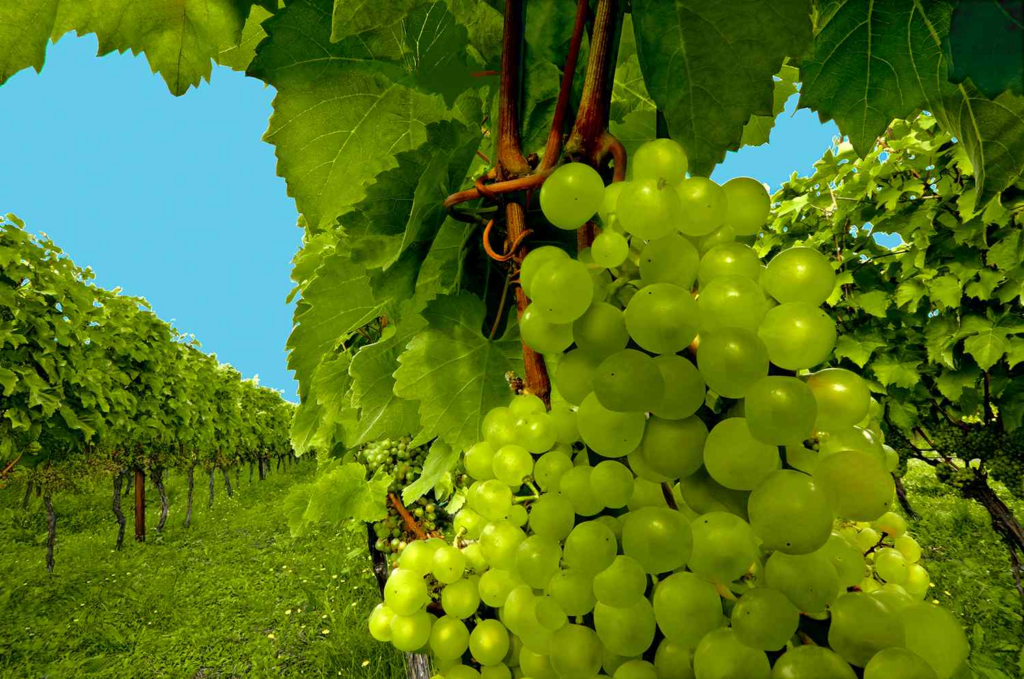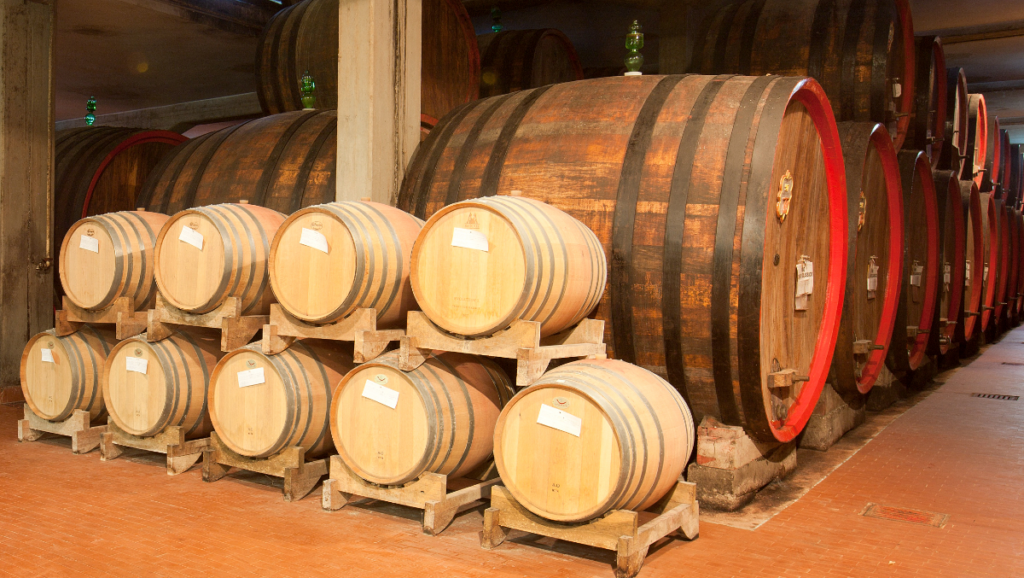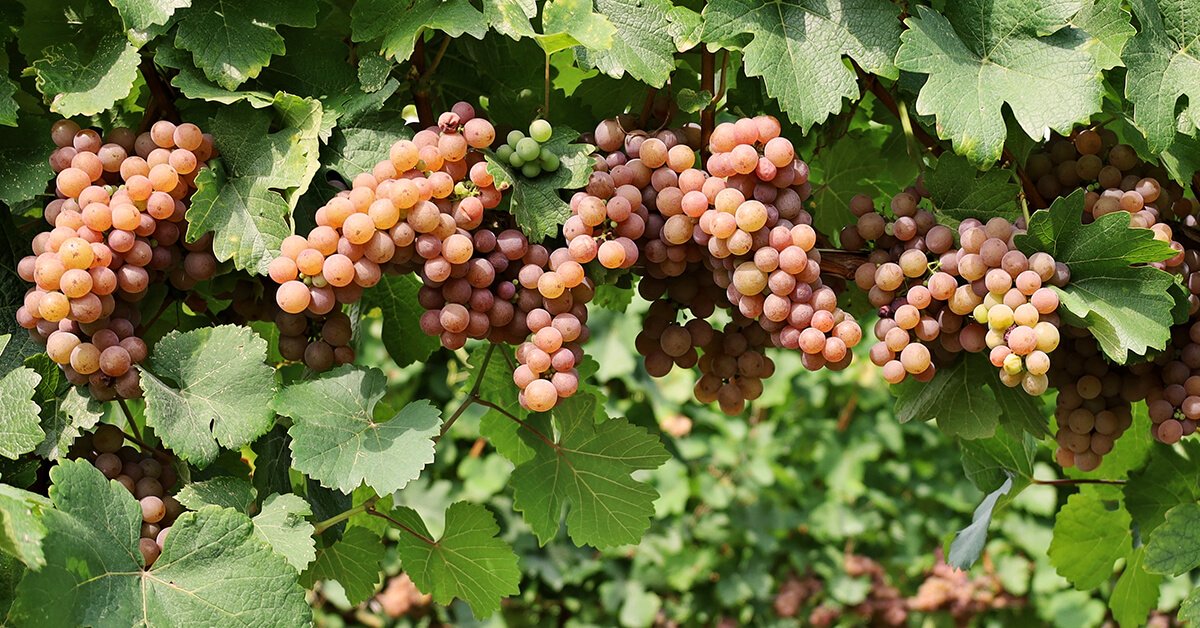Today, Pinot Gris and Pinot Grigio represent more than just grapes or wines; they represent lifestyles, culinary experiences, and, more importantly, the celebration of diversity in winemaking. From the elegant soirées of Paris to the bustling trattorias of Venice, these wines have become emblematic of the regions they come from, yet they resonate on a global scale.
As we venture deeper into their stories, you’ll come to see Pinot Gris and Pinot Grigio not as mere variations of a theme, but as reflections of the land, climate, and the hands that shape them. Their journey from vine to glass is rich with tradition, innovation, and passion – making them two of the most captivating characters in the vast narrative of wine. Cheers to the journey ahead!
Long Story Short: Key Differences between Pinot Gris and Grigio
Pinot Gris and Pinot Grigio are the same grape variety, but their stylistic differences arise from regional production methods: Pinot Gris, often from Alsace, is fuller-bodied with richer flavors, hinting at sweetness, while Pinot Grigio, popularly from Northeast Italy, is lighter, crisper, and more refreshing.
Think of them as two expressions of one grape, molded by terroir and tradition.
Origins and History
The tale of Pinot Gris and Pinot Grigio begins, unsurprisingly, intertwined, setting the scene for a journey that meanders through vineyards, across borders, and over time. Our tale is as much about culture and human endeavor as it is about the grape itself.
From France’s Heartland

Let’s begin in France’s famed wine region, Burgundy. It was here, amongst rolling hills and meticulously manicured vineyards, that the Pinot family first made its mark. The name “Pinot” itself, derived from the French word “pin” meaning pine, alludes to the grape’s pinecone-shaped clusters. Pinot Gris emerged as a natural mutation of the Pinot Noir grape, distinguishing itself with its grayish-blue hue — hence the term “gris,” French for gray.
In the heartland of French wine culture, Pinot Gris found its most expressive voice in Alsace, a region straddling France and Germany. Here, it’s celebrated for its sumptuous, full-bodied whites that sing of the land’s unique terroir and history. If wine could speak, Alsace’s Pinot Gris would tell tales of both German precision and French artistry.
Journey to the Italian Sun

Our story then takes a turn south, towards the sun-kissed terrains of Italy. Here, our grape undergoes not just a climatic change but a transformation in identity. Welcome, Pinot Grigio. While genetically identical to Pinot Gris, Italy’s interpretation of the grape skews towards a fresher, zestier expression. The northern regions, particularly Veneto and Friuli-Venezia Giulia, champion this varietal, crafting wines that are as crisp as a fresh mountain breeze and as refreshing as a plunge into the Adriatic Sea.
A Grape Without Borders
But the story doesn’t stop in Europe. The adaptability of this grape, coupled with its undeniable charm, led to its widespread cultivation. From the cool climates of New Zealand and Oregon to the varied terroirs of Australia and South America, both Pinot Gris and Pinot Grigio began to weave their stories in diverse soils and amidst different cultures.
Evolution in the Vineyard and Glass
Over time, as regions began to understand and embrace the grape’s nuances, two distinct styles emerged. In areas reminiscent of Alsace or inspired by its wine-making traditions, Pinot Gris often takes on a richer, more voluptuous profile. In contrast, regions leaning towards the Italian ethos produce Pinot Grigio with zest, lightness, and a mineral undertone.
In essence, the journey of Pinot Gris and Pinot Grigio is a testament to the beauty of evolution, adaptation, and cultural exchange. They’re more than just wines; they’re living histories in a bottle, capturing the essence of the regions they call home.
Basic Understanding: They’re the Same Grape!

Now, here’s where things might get a tad perplexing for the uninitiated, and a touch exciting for the wine aficionados among us. Pinot Gris and Pinot Grigio – are they siblings? Cousins? Doppelgängers? Well, brace yourself for a twist: they are, in fact, one and the same grape. That’s right! Like Clark Kent and Superman, they’re two expressions of a single entity.
The DNA Tie
Diving into the grape’s genetics, both Pinot Gris and Pinot Grigio are mutations of the grand Pinot family. It’s a family teeming with diversity, with members ranging from the iconic Pinot Noir to the lesser-known Pinot Blanc. These grapes have a tendency to mutate quite easily, which explains the various shades and nuances we find among them. Pinot Gris/Grigio, in particular, is recognized by its greyish-blue fruit, a color that sits somewhere between the deep red of Pinot Noir and the green of Pinot Blanc.
Terroir: The Artist Behind the Masterpiece
If you’ve ever wondered why wines, made from the same grape, can taste so vastly different, enter the concept of ‘terroir’. A French term, terroir is the tapestry of a vineyard’s location, encompassing soil, climate, altitude, and even the touch of the vintner. It’s the very soul of the wine, an ineffable quality that makes every vineyard unique.
For Pinot Gris and Pinot Grigio, terroir is the sculptor that shapes their character. In Alsace, where the soil is rich with minerals and the climate is continental, Pinot Gris boasts flavors that are deep, lush, and often honeyed. On the other hand, the Alpine breezes and stony soils of Northern Italy gift Pinot Grigio its hallmark crispness and light, lively character.
The Symphony of Climate
While the earth beneath the vine provides depth and complexity, the climate decides the tempo of the wine’s growth. Cool climates tend to stretch the grape’s ripening process, allowing for a beautiful build-up of acids, which translates to wines with crispness and longevity. Warm climates offer the reverse, with quicker ripening leading to wines that are fruit-forward, with a plush, round mouthfeel.
So, in a nutshell, while the genetic blueprint of Pinot Gris and Pinot Grigio is identical, it’s the symphony of terroir and climate that choreographs their dance in the glass. It’s a waltz of nature and nurture, of heritage and innovation, making each sip a taste of the land and sky from whence it came.
Viticulture and Winemaking Techniques

As we delve into the art and science of viticulture and winemaking, we unearth the myriad decisions and practices that transform a humble grape into the mesmerizing elixirs of Pinot Gris and Pinot Grigio. Let’s uncork the methods that define these wines’ characters.
Vineyard Practices: More Than Just Farming
At the heart of any great wine is the vineyard. It’s here that the story truly begins. Different regions, with their unique challenges and advantages, have their own philosophies about vine growth and health.
In places like Alsace, where Pinot Gris has an established legacy, the vines might be trained low to the ground using the “Guyot” system. This provides better sun exposure and ensures a balanced ripening of grapes. Contrast this with parts of Italy, where the “Pergola” system is often preferred for Pinot Grigio, allowing vines to grow overhead, protecting the grapes from the intense sun and optimizing shade.
Harvesting: Timing is Everything
Harvesting is one of the most crucial decisions in the winemaking calendar. The exact moment of picking determines the grape’s sugar, acid, and tannin levels. For Pinot Grigio, which is celebrated for its bright and zesty character, an earlier harvest is common. This retains the grape’s natural acidity, resulting in a fresher, more vibrant wine.
Pinot Gris, especially those from regions like Alsace, might be left on the vine a tad longer, allowing sugars to develop, leading to a fuller, richer wine, sometimes with a hint of sweetness.
Winemaking: From Grape to Glass
Once harvested, the winemaking magic begins. For Pinot Grigio, the emphasis is often on preserving its lively, aromatic qualities. Grapes are usually pressed quickly, and the juice is fermented in stainless steel tanks to maintain its freshness.
With Pinot Gris, especially those aiming for a richer style, some winemakers might allow the grape juice to have extended contact with the skins (a method known as ‘maceration’). This not only enhances the wine’s color but also imparts additional complexity and structure.
Aging: The Graceful Evolution
A wine’s journey doesn’t end once fermentation is over. The aging process allows it to evolve, mellow, and often, become more complex. While many Pinot Grigios are enjoyed young and are seldom aged for extended periods, there are exceptions, especially from top producers who may age them on their lees (dead yeast cells) to add more body and flavor complexity.
Pinot Gris, with its intrinsic richness, often benefits from aging. In regions like Alsace, it’s not uncommon for these wines to be aged in old oak barrels. Unlike the strong character of new oak, which can impart vanilla and toasty notes, old oak is more subtle, allowing the wine to breathe and evolve without overshadowing its innate flavors.
Sensory Profiles

As we swirl, sniff, and savor our way through Pinot Gris and Pinot Grigio, we embark on a sensory exploration, unveiling the symphony of aromas, flavors, and textures these wines present. Let’s tease apart the sensory tapestries of these two wines, appreciating the intricate notes and nuances that define each.
Pinot Gris
Aromas and Flavors: The bouquet of Pinot Gris is like a fragrant orchard in full bloom. You’re greeted with the lush aromas of ripe pear and apple. But linger a little longer, and the complexity unfolds — hints of tropical fruits like lychee and pineapple, whispers of spices reminiscent of nutmeg or cinnamon, and often, a delightful drizzle of honey that adds a touch of sweetness to its profile.
Texture and Body: Pinot Gris often seduces with its voluptuous character. It graces the palate with a fuller body, which can sometimes feel almost oily or velvety in its richness. This weightiness makes it an exceptional companion for dishes with a bit more heft or creamy textures.
Pinot Grigio
Aromas and Flavors: Think of Pinot Grigio as a crisp, sunlit day in spring. The first sniff is invigorating, with zesty lime and tart green apple taking center stage. Dive deeper, and you’ll uncover delicate floral undertones, akin to white blossoms after a gentle rain. And for those with a keen nose, there’s often a subtle almond note, like a faint echo from a distant Italian piazza.
Texture and Body: In the ballet of wines, Pinot Grigio is the sprightly dancer. Light to medium-bodied, it pirouettes on the palate with grace and agility. Its finish is characteristically crisp, leaving a refreshing, zesty aftertaste that beckons for another sip, especially on a warm day or alongside lighter fare.
Major Production Regions
The tale of Pinot Gris and Pinot Grigio is as much about place as it is about grape. Like a skilled artist, each region paints its unique brushstrokes on this canvas, crafting wines that resonate with the terroir’s voice. Let’s embark on a geographical tour, tracing the footprints of these wines across the globe.
Pinot Gris
Alsace, France: Tucked between the Vosges mountains and the Rhine river, Alsace is the spiritual home of Pinot Gris. Here, it crafts wines that are nothing short of opulent. With a nose teeming with heady aromatics and a palate rich with spices, Alsacian Pinot Gris often flirts with a touch of sweetness, making it a versatile partner at the dining table. The terroir, a mosaic of soils from granite to limestone, lends a minerality that’s unmistakably Alsacian.
Oregon, USA: As we cross the Atlantic and touch down on American soil, Oregon’s Willamette Valley stands out as a beacon for New World Pinot Gris. Oregonian expressions are a delightful blend of Old and New World, marrying Alsace’s depth with fresh fruit characteristics. Think ripe peaches, fresh pear, and a hint of wet stone. Oregon’s cool climate and dedication to sustainable viticulture further accentuate the grape’s character.
Other Notable Regions: Pinot Gris has also found homes in regions like New Zealand, where the cool maritime climate teases out its zesty side, and British Columbia, Canada, where the grape takes on a lovely balance of fruit and acidity.
Pinot Grigio
Northeast Italy: The regions of Veneto, Friuli-Venezia Giulia, and Alto Adige form the triumvirate of Italian Pinot Grigio excellence. Here, under the shadow of the Alps, the grape delivers wines that are the epitome of refreshment: crisp, light, and with a mineral backbone that’s reminiscent of a mountain stream. It’s the kind of wine that feels at home in a bustling Italian piazza or with a plate of fresh seafood.
Australia: The Land Down Under, while relatively new to the Pinot Grigio game, has made quite the entrance. Regions like Victoria and Adelaide Hills are crafting modern renditions of this grape, delivering wines that strike a balance between the zesty Italian style and the richer Alsatian approach. Expect nuances of ripe citrus, green pear, and a whisper of tropical fruit, often underpinned by a refreshing acidity.
Other Notable Regions: Beyond Italy and Australia, places like California’s cooler coastal regions and Argentina’s high-altitude vineyards are experimenting with Pinot Grigio, adding their own terroir-driven twists.
Pairing Suggestions

One of the supreme joys of wine is how it can elevate a meal, creating a harmonious interplay between food and drink. Like a conductor with a baton, the right wine can orchestrate a culinary symphony. Let’s delve into the pairing potentials of Pinot Gris and Pinot Grigio, discovering dishes that sing in perfect harmony with these wines.
Pinot Gris
Roast Chicken: The rich, succulent nature of a perfectly roasted chicken, with its golden skin and juicy flesh, finds an adept partner in Pinot Gris. The wine’s fuller body embraces the bird’s textures, while its fruit-forward profile contrasts beautifully with the savory notes of the roast.
Cream-based Sauces: Be it a sumptuous Alfredo or a delicate béchamel, cream-based sauces demand a wine that can stand up to their richness without overshadowing. Enter Pinot Gris, whose weighty palate and subtle aromatic undertones seamlessly meld with the creamy textures, offering a delightful dance of flavors.
Autumnal Dishes: Think dishes that showcase the bounty of fall – butternut squash risottos, mushroom tartlets, or a heartwarming pumpkin soup. The inherent spiciness and robustness of Pinot Gris resonate with these earthy, comforting dishes, making every bite and sip a toast to the season.
Pinot Grigio
Seafood: The pristine, refreshing character of Pinot Grigio is like a sea breeze in a glass. It’s no wonder it pairs splendidly with seafood, from delicate branzino to zesty ceviche. The wine’s crispness accentuates the ocean’s flavors while its light body ensures the seafood remains the star.
Salads: Whether it’s a classic Caprese adorned with basil and mozzarella or a zingy arugula salad punctuated with lemon vinaigrette, Pinot Grigio’s zest and minerality amplify the freshness of salads. It’s like summer on a plate, complemented by a splash of Italian sunshine in your glass.
Dishes with Citrus and Herb Components: Lemon-infused pasta, herby chicken piccata, or tangy citrus-marinated olives – dishes that champion the bright notes of citrus and herbs find a kindred spirit in Pinot Grigio. The wine’s lively acidity and aromatic profile echo these flavors, making every bite a vibrant celebration.
Optimal Temperatures
Storage: Both Pinot Gris and Pinot Grigio thrive when stored in a cool, consistent environment, ideally between 52-55°F (11-13°C). This temperature zone preserves the wine’s delicate aromatics and structural integrity. Whether you have a dedicated wine fridge or a cool cellar, ensure there’s minimal temperature fluctuation.
Serving: Temperature can dramatically shape our perception of a wine. For Pinot Gris, aim for a slightly warmer 50-55°F (10-13°C) to unveil its rich textures and layered aromas. Pinot Grigio, with its zestier profile, shines brightest at a cooler 45-50°F (7-10°C), allowing its crispness to truly sparkle.
Aging Potential
Pinot Gris: While many are crafted for immediate enjoyment, certain Pinot Gris, especially those from Alsace or with some residual sweetness, have the backbone to age gracefully. These can develop more complex, honeyed, and nutty profiles over 5-10 years, though it’s essential to store them under optimal conditions.
Pinot Grigio: This wine is typically celebrated for its youthful exuberance. The charm of Pinot Grigio lies in its fresh, lively character, so it’s best consumed within 1-3 years of bottling. Aging it longer might mellow its vivacity, which is the heart of its appeal.
Recommended Wines to Try
Navigating the world of Pinot Gris and Pinot Grigio can be akin to exploring a sprawling vineyard, each row revealing distinct treasures. As your trusty sommelier-guide, allow me to present a curated list that encapsulates the spirit, depth, and diversity of these grapes. From timeless classics to hidden gems, there’s a wine here to satiate every palate and pocket.
Pinot Gris:

Domaine Zind-Humbrecht Pinot Gris, Alsace, France: A gold standard from Alsace, this wine showcases opulent tropical fruit notes, underlined by honey and smoky minerals. A textured palate promises a lavish sip.
Willamette Valley Vineyards Pinot Gris, Oregon, USA: A New World charmer, it presents fresh orchard fruits, vibrant acidity, and a touch of creaminess. A testament to Oregon’s prowess with this grape.
Greywacke Pinot Gris, Marlborough, New Zealand: Venturing to the Southern Hemisphere, this Kiwi offering teases with nuances of ripe pear, spice, and a whisper of sweetness. An exotic journey in a glass.
Trimbach Pinot Gris Reserve, Alsace, France: With its lineage tracing back centuries, Trimbach’s Reserve is a masterclass in balance, boasting stone fruits, earthy undertones, and a structured finish.
J Vineyards Pinot Gris, California, USA: Hailing from the sun-drenched Californian vineyards, anticipate a burst of citrus, melon, and a refreshingly crisp finish.
Pinot Grigio:

Santa Margherita Pinot Grigio, Alto Adige, Italy: Often dubbed the quintessential Pinot Grigio, it enchants with its delicate floral aroma, green apple zest, and a minerally tail.
Jermann Pinot Grigio, Friuli-Venezia Giulia, Italy: A stellar representation of Northeast Italy’s terroir, this wine unveils layers of citrus, almonds, and crisp mountain air.
Kris Pinot Grigio, delle Venezie, Italy: Friendly on the wallet yet rich in character, it’s a delightful mingle of stone fruits, blossoms, and a zesty tang.
Innocent Bystander Pinot Gris, Yarra Valley, Australia: Yes, it’s labeled ‘Gris’, but its style leans closer to the Grigio realm. Relish in its playful tropical fruits, balanced acidity, and the warmth of the Aussie sun.
Elena Walch Pinot Grigio, Alto Adige, Italy: A sophisticated sip, it weaves a tale of mountain orchards, fresh herbs, and alpine purity.
FAQs
Is Pinot Gris sweeter than Pinot Grigio?
Typically, Pinot Gris, especially those from Alsace, France, can have a slightly sweeter profile due to a fuller body and often a touch of residual sugar. In contrast, Pinot Grigio, especially from Northeast Italy, is known for its crisp, dry, and refreshing nature. However, the sweetness level can vary depending on the winemaker’s intention and the region of production.
Is Pinot Gris sweet or dry?
Pinot Gris can be both. While many Pinot Gris wines, particularly those from Alsace, might exhibit a hint of sweetness, they can also be vinified to be completely dry. The perception of sweetness is also influenced by the wine’s fruitiness and body. For example, an Oregon Pinot Gris might be dry but have such ripe fruit flavors that it comes across as slightly sweet on the palate.
Why is Pinot Gris so popular?
Pinot Gris owes its popularity to several factors:
Versatility: The grape can produce wines ranging from light and crisp to full-bodied and luscious, catering to a broad spectrum of wine drinkers.
Food-friendly Nature: Its balanced acidity and flavor profile make it a delightful partner to a variety of dishes.
Global Presence: From the revered vineyards of Alsace to the pioneering regions in New Zealand and Oregon, the grape’s widespread cultivation has led to diverse styles, capturing the imagination of wine enthusiasts globally.
Approachable Profile: Its often fruit-forward and aromatic nature makes Pinot Gris a favorite for both seasoned wine lovers and those new to the world of wine.
What is the taste profile of Pinot Gris?
Pinot Gris is known for its aromatic and flavorful profile. Common descriptors include pear, ripe apple, stone fruit (like peach and apricot), honey, and sometimes tropical notes like pineapple. Additionally, depending on where it’s grown and how it’s made, it can also display hints of spice, wet stone, and almond. The wine is typically medium to full-bodied, often with a rich texture that can sometimes be described as “oily” or “velvety.”

